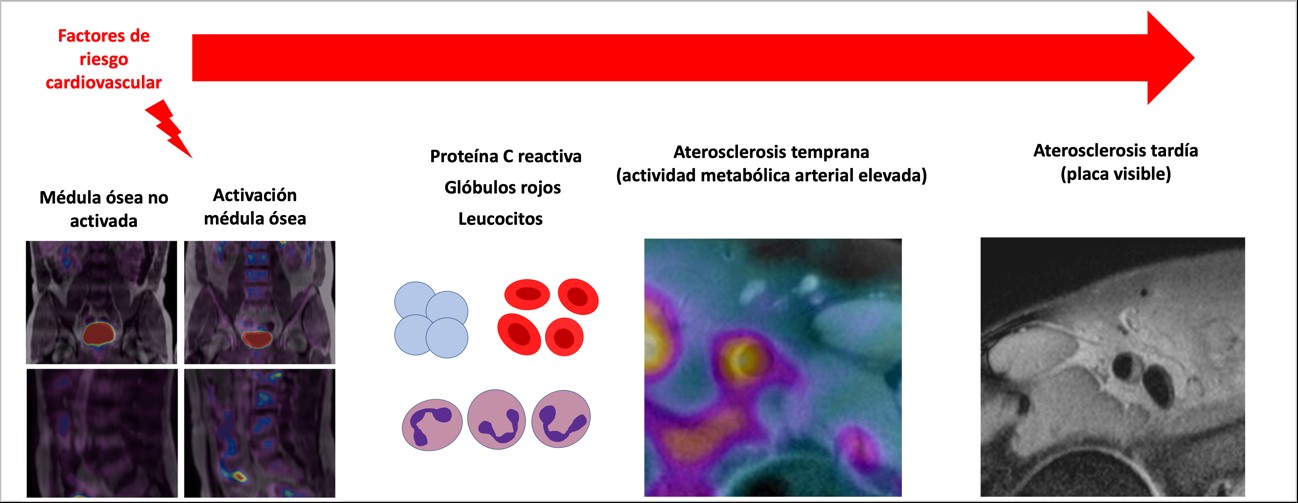EHJ: Bone marrow contributes to the development of atherosclerosis
The new discovery suggests new research avenues toward the discovery of interventions to prevent or arrest atherosclerosis
The activation of the bone marrow appears to play a key role in the origin and development of atherosclerosis, the pathological process underlying cardiovascular conditions such as myocardial infarction and stroke. A study carried out by scientists at the entro Nacional de Investigaciones Cardiovasculares (CNIC) and led by cardiologists Valentín Fuster and Borja Ibáñez suggests that the bone marrow is activated in response to known cardiovascular risk factors. In the study, published in the European Heart Journal, the researchers show that these risk factors lead to an increase in the number of circulating inflammatory cells, which go on to trigger the initiation and subsequent progression of atherosclerotic disease.
Atherosclerosis is a progressive deposition of fats and inflammatory cells in the arterial wall, resulting in the formation of atheroma plaques. After many years of silent, symptom-free growth and development, atheroma plaques can erode or rupture, resulting in a superimposed thrombus that can trigger acute myocardial infarction, stroke, or sudden cardiac death.
Atherosclerosis is the most frequent cause of death in the world and is considered a ‘silent killer’ because it develops quietly for years before producing symptoms. Identifying atherosclerosis in its initial phases, before symptoms appear, is a major goal of the PESA-CNIC-Santander (Progression of Early Subclinical atherosclerosis) study. This study was launched in 2010 as a collaboration between the CNIC and Santander Bank and is led by Dr. Valentín Fuster, CNIC Director General and cardiologist and Medical Director at Mount Sinai Hospital in New York.
EThe study, published in the European Heart Journal, was conducted with participants in the PESA study, a partnership between the CNIC and Santander Bank led by Dr. Valentín Fuster
The new study establishes a basis for fighting this disease by attacking the roots of its development. According to Borja Ibáñez, CNIC Clinical Research Director, cardiologist at Hospital Universitario Fundación Jiménez Díaz, and a group leader in the Spanish cardiovascular research network (CIBERCV), “early detection of atherosclerosis allows us to gain knowledge about the mechanisms that produce it, opening avenues toward identifying new treatments able to prevent the progression of this fatal disease.”
Dr. Ibáñez, who directed the study together with Valentín Fuster, explained that although atherosclerosis has been investigated for many decades, the mechanisms that initiate the disease remain unclear.
CNIC cardiologist and study first author Ana Devesa explained that the cardiovascular risk factors that activate the bone marrow are those linked to metabolic syndrome: central obesity (the accumulation of abdominal fat), a high blood triglycerides, low HDL cholesterol, elevated blood glucose, insulin resistance, and high blood pressure.
These factors trigger an increase in metabolic activity in the blood marrow that can be detected with the advanced image techniques available at the CNIC, such as hybrid positron emission tomography (PET)–magnetic resonance imaging (MRI). “The increased metabolic activity of the bone marrow unleashes an inflammatory process that activates atherosclerosis, from its earliest stages through to the appearance of established plaques,” said Dr. Devesa.
PESA CNIC-SANTANDER study
The PESA CNIC-SANTANDER study is a joint venture between the CNIC and Santander Bank and has been running for more than 10 years. The study population comprises 4200 bank employees who were aged from 40 to 55 years at the start of the study and were in apparent good health. Over the course of the study, these participants undergo periodic examinations with cutting-edge imaging techniques, as well as providing blood samples for screening in advanced omics studies.
The PESA study was recently extended until 2029, so that follow-up data will eventually be collected from almost all the original participants, a feat unmatched in worldwide cardiovascular research.
PESA-CNIC-Santander is considered one of the most important cardiovascular prevention studies in the world. As Dr. Valentín Fuster explained, “PESA is the CNIC’s flagship study, providing a focus for many of the center’s pioneering research groups, each a leader in a defined area of cardiovascular disease. This joining together of basic and clinical researchers to investigate a large cohort like PESA is a unique venture in cardiovascular research.











